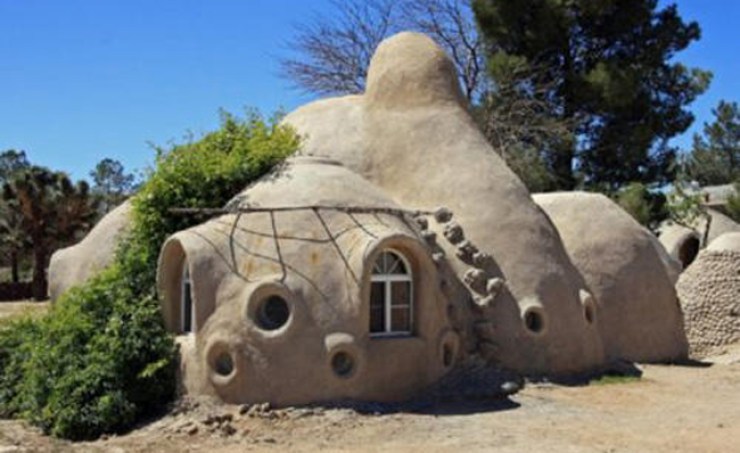Environmentalist’s best kept secret and the concrete industry’s worst nightmare…
… the earthbag method means that you can build a small retreat to withstand bullets, floods, hurricanes, storms and fires much better than a conventional house.
And all at a fraction of the cost!
Earthbag construction is a hot topic in underground circles but has yet to hit the mainstream.
First used by the military to make bunkers and temporary army buildings, the earthbag building system became a family necessity in some war zones. There are also a few video guides on how to turn your home into an impregnable fortress.
And I’m pretty sure that this method will become pretty popular among survivalists and cautious people in general. And here is why:
INDESTRUCTIBLE
Earthbag buildings are tough and have some serious credentials to prove it:
In Nepal’s recent earthquakes, the entire village of Sangachok was flattened, with the exception of one building. This school building is now being used as a shelter for the majority of the community who’ve lost their homes to the quake. And guess what this building is made of? That’s right, earthbags.
The polypropylene bags filled with soil, laid like bricks and tamped down into place proved too tough for the 7.8 earthquake to defeat.
With its plaster, attached to the bags by chicken wire mesh, it looks just like a regular concrete building. It’s just much tougher.

Emergency shelters are now being put up in Nepal using this method, based on the success in rebuilding in Haiti after their earthquake in 2010.
It was the military that first used earth and sandbag construction and have been doing so for at least a century. Used to make bunkers and temporary army buildings, the ability of earthbags to take bullets in and not let them out makes them indispensible for those inwar zones or preparing for dangerous situations.
We don’t have to look too far to get proof of earthbag’s waterproof properties. Bags filled with earth or sand are used for flood control worldwide with great success. Though the burlap bags commonly used degrade when exposed to water for a long time, polypropylene is totally water resistant, so is the ideal choice for waterproofing.
In earthbag construction, the walls are constructed on top of simple rubble trenches with french drains to keep rainwater water away from the bags. The first few courses of bags are filled with gravel for best results.
DIRT CHEAP…
…literally!
You’ll still need to buy windows, doors, fixtures, fittings and roof materials, but the cost for the bulk of the construction is dramatically slashed.
Polypropylene bags go as cheap at 10 cents each or even less when you buy in bulk and search around for a good deal. Fill them with soil from your own land and there’s only barbed wire to buy to complete your wall. This is laid between the courses in two strips to create friction between them.

Finishing plasters for the outside and the inside will vary depending on which options best suit your needs. Concrete, lime, clay or earth based plasters will attract different price tags. Don’t be tempted to skip the plastering step – polypropylene bags degrade under prolonged UV exposure. Chicken wire or fishing net draped over the bags before the plaster is applied creates superior strength in the wall.
Tamped earth or soil-cement floors, sealed and varnished, offer a great low-cost alternative to concrete slab and help with temperature control and insulation.
You’ll also save a bundle on transport costs, as most of the material (soil) is already on site.
This method makes hard to access areas easily buildable, perfect for those who want their shelter way off the beaten track.
Construction costs are also slashed by lack of tools needed. Without so much as a cement mixer or a drill, a shelter or house can be erected with no need for a source of electricity or water during construction.
Of course it depends where you want to build and what finishes you choose, but at an average of $10 per square foot with labor costs negligible to none, a sizeable shelter of 500 square feet can be built for $5000.
DO IT YOURSELF
One of the greatest things about earthbag construction is that it’s so easy to do. There’s no need to pay out a load of money in labor costs. A team will speed things up, but it can even be done alone.
Loading bags with earth where they’re being laid rather than heaving them up fully loaded saves a whole load of strain, too.
During construction, frames for windows and doors can be installed just as in conventional block building, though lintels must be wider than usual to support the weight of the earthbags. Pipes can be inserted between the courses for plumbing to be installed later.

FREEDOM TO INNOVATE
Concrete blocks and other conventional construction methods are good for building box shaped buildings but not much else. Complicated shapes and creative designs cause prices to skyrocket.
Earthbags are another story, their versatility being one of their main benefits. Vaulted ceilings and arches are easily achievable with earthbags and scientific tests have proved their strength.
Under great loads they deform rather than collapse, meaning they can be fixed after a disaster rather than being a total write-off.
Semi-underground shelters built into hills or backfilled on top of are viable options and roundhouses are actually the shape of choice for hurricane resistance. Storm cellars and root cellars are possible, too, as well as earthbag cisterns, retaining walls and planters. If you prefer square or rectangular styles, that’s no problem either, though it will need strengthening in the corners with rebar or buttresses.
Earthbag building gives you the ultimate freedom to create according to your vision. Whether it be an ultimate underground storm shelter or a multi-family homestead, earthbag building can make your dream affordable, attainable and sustainable.
Original story from http://offgridquest.com
